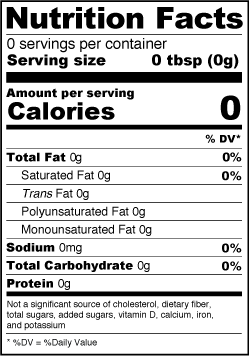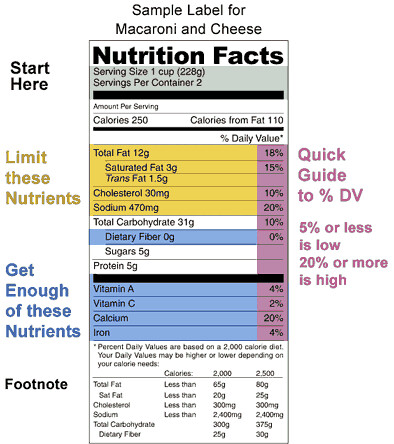45 food labels serving size
Serving size on food label - HealthyLife | WeRIndia According to FDA, new Nutrition facts food label depicts the serving sizes based on the amount of food people typically consume, rather than how much a person should consume. What we should know is, serving sizes are not the reflection of what we consume. Our food habits and portion that we consume have changed a lot in past two decades. Food Labels and Serving Size - DTN Progressive Farmer The concept of "one serving size fits all" seems unrealistic. Perhaps benchmarks of 100, 200, 300 calories and so forth should be presented. This is not the first flap over labeling that has...
Serving size - Canada.ca Serving size is listed in a common household measure. It also is listed in grams or millilitres depending on the type of food. Common household measures include: a fraction of a food such as 1/4 pizza (90 g) number of pieces such as 4 crackers (20 g) cups, teaspoons or tablespoons (3/4 cup of yogurt [175 g] or 1 tablespoon of peanut butter [15 g] )

Food labels serving size
Serving Size for Food Products - LabelCalc How to Determine Serving Size. Determining serving size is as simple as understanding the FDA guidelines around appropriate portion sizes for food products. Individual serving sizes can be found on the FDA RACC Table. (Download our Determining Serving Size guide and scroll to page 3 to view the complete guide at a quick glance, go ahead, we ... Understanding the FDA Food Label: The Serving Size The serving size is located at the top of the FDA food label. It not only tells you the amount of a single serving, but it will tell you how many servings are in the container. For example, the label on a can of pears may note that the serving size is ½ cup and that the can contains three servings. Serving Size vs. Portion Size Food Serving Sizes Have a Reality Check | FDA In some cases, the reference amounts used to set serving sizes are smaller. Today's individually packaged yogurts more often come in 6-ounce containers, versus the previous 8-ounce ones. The FDA is...
Food labels serving size. How to Determine Serving Size - LabelCalc 2. Use your RACC to determine serving size: Portion out your product according to the RACC (i.e. weigh out 115 grams of your cereal). Then, measure it in cups, pieces, or as a fraction of the package in order to find the serving size in familiar units. Cups: Take the 115 grams of cereal and measure it in a measuring cup. This value will appear ... Serving Size - LabelCalc In May of 2016 the U.S. Food and Drug Administration (FDA) published a final rule regarding the serving sizes of food. The final rule required new nutrition labeling as well as changing the definition of single-serving containers. ... LabelCalc's nutrition labels adhere to the new serving size, single-serving, and dual-column labeling ... Nutrition Labels: Who Determines What a Serving Size Is? - MEL Magazine Ice cream nutrition labels have been modified accordingly, with a pint of Ben & Jerry's now defined as three servings instead of four. Soda, meanwhile, has increasingly been sold in larger containers — from a 12-ounce can to 20-ounce bottles. Nutrition labels now better reflect those increases, too. Suggested Servings from Each Food Group - American Heart Association Whole grain rather than refined grain products. Six (6) servings of grains per day. Examples of one serving of grains: One slice bread. One small tortilla. 1 cup ready-to-eat cereal flakes. 1 ounce (⅛ cup) uncooked pasta or rice. ½ cup cooked rice, pasta or cereal. 3 cups popped popcorn.
My Food Label: Determining the Serving Size - ReciPal Thus, our serving size should be listed as "1 cookie (40 grams)" or "1 piece (40 grams)". If our average cookie is 60 grams, we show it as "1/2 cookie (30 grams)". And if an average cookie is 10 grams, we list it as "3 cookies (30 grams)". Gaming the Rules A lot of companies game the system and actually use the FDA guidelines to their advantage. How to Understand and Use the Nutrition Facts Label | FDA - U.S. Food ... Pay attention to the serving size, especially how many servings there are in the food package. For example, you might ask yourself if you are consuming ½ serving, 1 serving, or more. In the sample... No, serving sizes on food labels don't tell us how much we should eat To make it even more confusing, in the same brand of rice, a 450g family pack could be labelled as having four serves, with each serve 112g. That's 10% smaller than the serving size in the smaller... Serving Size on the New Nutrition Facts Label | FDA - U.S. Food and ... First, look at the serving size and the number of servings per container, which are at the top of the label. The serving size is shown as a common household measure that is appropriate to the food...
Serving Size Updates on the New Nutrition Facts Label | FDA On the original Nutrition Facts label, the serving size was 1/2 cup (66g), while on the new Nutrition Facts label, the serving size is 2/3 cup (88g). While it may look like the calories and... Guidance for Industry: Food Labeling: Serving Sizes of Foods That Can ... In the Federal Register of May 27, 2016 (81 FR 34000), we published a final rule pertaining to serving sizes for food.The final rule amends the definition of a single-serving container, requires ... How To Read Food and Beverage Labels - National Institute on Aging At the top of the Nutrition Facts label, you will find the total number of servings in the container and the food or beverage's serving size. The serving size on the label is based on the amount of food that people may typically eat at one time and is not a recommendation of how much to eat. Read more about serving and portion sizes. PDF Activity: Food Labels and Serving Sizes - UNC Gillings School of Global ... 3. Read aloud the directions at the top of the Food Labels and Serving Sizes handout and instruct participants to fill out the front page of the handout based on the amount of food they would each normally eat versus the recommended serving size. 4. Using the copies of Nutrition Facts labels of various foods, have participants fill in the
How to Read Serving Sizes on Nutrition Labels - Lark A portion size is the amount of food you serve yourself for a meal or a snack. A serving size is a measured amount of food (such as a tablespoon or a fraction like 1/8th) that is the "Nutrition Facts" found on the back of food. A single portion can contain multiple servings.
Food Label Serving Sizes Manipulation - Truthful Nutrition Values? There are a few guidelines that have been developed through experience to help consumers in comparing serving sizes, some of them are as listed below: i. The size of 3 ounces of meat is equivalent to a deck of cards. ii. The quantity of a cup of rice is equivalent to half a baseball. iii.
Understanding Serving Size Values on Food Labels - Nina Cherie Franklin The "serving size" of a packaged product is always shown at the very top of the Nutrition Facts label. This is essentially the amount of food recommended to account for one serving. Serving sizes are typically listed in pieces, grams, ounces, tablespoons, cups or other common units of measurement. For instance, a serving of baby carrots ...
Larger Serving Sizes On Food Labels May Encourage Us to Eat Less - HuffPost Let's hope that this occurs in reality if FDA does, in fact, increase the serving sizes on food labels (which the agency proposed doing for nearly 17% of packaged foods). For example, FDA is proposing to increase the serving size of ice cream from ½ cup to 1 cup. Rather than view the 1 cup serving as a recommendation, I hope that instead ...
Serving sizes on junk foods labels are misleading For junk food, a single serve is recommended to be 600kj. 2. While a manufacturer is required to state a serving size and associated nutritional information, the study found huge variations as to how much a single serving size actually is, and a single serve of many products provided more than 600kj.
Food Labels | CDC - Centers for Disease Control and Prevention Check the Serving size first. All the numbers on this label are for a 2/3-cup serving. This package has 8 servings. If you eat the whole thing, you are eating 8 times the amount of calories, carbs, fat, etc., shown on the label. Total Carbohydrate shows you types of carbs in the food, including sugar and fiber.
4 Things To Look Out For While Buying Packaged Food 1. Serving Size: Every food label has a serving size mentioned on it. While some types of packed food have one serving, others may contain more than one serving. The rest of the information on the label is listed with respect to this serving size. For example, the nutritional facts listed on a box of juice may be according to a serving size of ...
Serving Sizes and Other Food Label Secrets - DSM - Diabetes Self-Management Reading food labels. An article by diabetes educators Laura Hieronymus and Belinda Carlisle explains that food labels put important information in different places. The Nutrition Facts panel should list the amounts of nutrients in the food or supplement. The serving size is usually the first thing listed.
Serving Sizes In The Food Guide Pyramid And On Food Labels Years ago, the serving size on the food label was left to the whim of the food manufacturer. It made comparison shopping in the grocery aisle an accounting nightmare. For example, a serving of frozen yogurt could have been anywhere from 1/3 cup to 3/4 cup depending on the manufacturer. A health-conscious person would need to go shopping with a ...
Serving Size vs Portion Size Is There a Difference Measures about 1 cup An appropriate portion size for raw or cooked vegetables, whole fruit or 100% fruit juice A tennis ball or small, scooped handful Measures about ½ cup Equal to 1-ounce equivalent for grains, such as pasta, rice and oatmeal A deck of cards or the palm of the hand Measures about 3 ounce-equivalents
Food Serving Sizes Have a Reality Check | FDA In some cases, the reference amounts used to set serving sizes are smaller. Today's individually packaged yogurts more often come in 6-ounce containers, versus the previous 8-ounce ones. The FDA is...
Understanding the FDA Food Label: The Serving Size The serving size is located at the top of the FDA food label. It not only tells you the amount of a single serving, but it will tell you how many servings are in the container. For example, the label on a can of pears may note that the serving size is ½ cup and that the can contains three servings. Serving Size vs. Portion Size
Serving Size for Food Products - LabelCalc How to Determine Serving Size. Determining serving size is as simple as understanding the FDA guidelines around appropriate portion sizes for food products. Individual serving sizes can be found on the FDA RACC Table. (Download our Determining Serving Size guide and scroll to page 3 to view the complete guide at a quick glance, go ahead, we ...









Post a Comment for "45 food labels serving size"